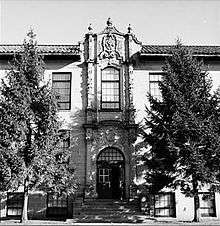Detroit Collaborative Design Center
 Warren Loranger Architecture Building University of Detroit Mercy | |
| Abbreviation | DCDC |
|---|---|
| Established | 1994 |
| Type | Non-profit; fee & grant support |
| Purpose | Metro Detroit renewal |
| Headquarters | University of Detroit Mercy |
| Location |
|
First director | Fr. Terrence Curry, SJ [1] |
Director | Dan Pitera (since 2000)[2] |
| Affiliations | Jesuits, Sisters of Mercy |
Staff | Six and one to three interns |
| Award(s) |
Focus Hope, 2015[3] NCARB Prize, 2009[4] |
| Website | DCDC-UDM |
Detroit Collaborative Design Center (DCDC) is an outreach of University of Detroit Mercy School of Architecture in response to the decline of Detroit, Michigan, with changes in the auto industry. It uses participatory community design to enhance the appearance and functionality of residential, business, and recreational areas as well as community centers, schools, and streetscapes.
History
In 1993 Stephen Vogel envisioned Neighborhood Design Studio within the Detroit Mercy School of Architecture, of which he was dean, to enhance the abilities of local leaders to produce quality design through broad-based community participation. He enlisted Fr. Terrence Curry from the faculty to establish the studio. Students assisted in bringing together stakeholders and expertise for planning: housing, mixed-use, retail, streetscapes, emergency shelters. Over time the studio evolved into the Detroit Collaborative Design Center.[5]
In 2000 Curry accepted a Loeb Fellowship at Harvard University and Dan Pitera has been director ever since. Pitera had been president of the Center for Critical Architecture in San Francisco. Under him DCDC projects have diversified to include new construction, renovation, neighborhood and strategic planning, landscape design, and experimental installations. Six professionals and one to three student interns make up the staff of the Center. Since 1994 the DCDC has worked with over 80 Detroit nonprofit organizations, community groups, and philanthropic foundations.[5]
Process
The Neighborhood Engagement Workshop (NEW) process used by the DCDC was explained in the documentary Detroit Collaborative Design Center ...amplifying the diminished voice.[6] Creativity is elicited from neighborhood members themselves at workshops which bring together about 25 participants – residents, youth, business owners, government representatives – to plan their own projects, discussing neighborhood assets and needs and harmonizing diverse perspectives. Input from the community is sought through workshop participants, surveys, comment boxes, and public events. This also leads to funding and to the emergence of community advocates and community development groups.[5]
Since 2011 the DCDC has produced a series of Community How-to Guides to bridge the gap between emerging and established organizations, between on-the-ground actions and long-term plans, opening lines of communication and fostering effective collaboration, The guides highlight lessons learned and helpful information for those involved in neighborhood and city development processes and projects.[5]
References
- ↑ Curry. Retrieved 3/18/16.
- ↑ Pitera. Retrieved 3/18/16.
- ↑ Focus Hope. Retrieved 3/18/16.
- ↑ NCARB. Retrieved 3/18/16.
- 1 2 3 4 DCDC-UDM. Retrieved March 18, 2016.
- ↑ Sheri Blake and Tadashi Orui. Winnipeg: Sou International, 2006.
Coordinates: 42°25′0.98″N 83°8′23.54″W / 42.4169389°N 83.1398722°W